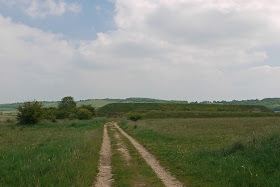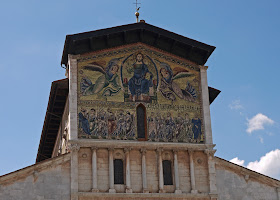Martin Down National Nature Reserve is a famous site for butterflies and wildflowers and I have decided to launch a new project of journeying specifically to such sites, rather than simply walking in conveniently located bits of countryside. The reserve consists of two distinct parts, a wooded area on one side of the A354 near Salisbury and a large area of chalk grassland on the other side.
A meadow separates the wood from the road and the track running along the edge of the wood marks the route of a Roman road.
A grassy track leads to the first of a series of clearings which are a feature of the wood and indicate how it is being managed for wildlife. I have read the elusive Duke of Burgundy has been seen here, but at first all I see are lots of Brimstones, mainly males (a deeper shape of yellow), flying around presumably looking for mates. I also heard my first cuckoo of the year.
My first picture subject is a reasonably large moth, which a bit of searching revealed to be a Treble Bar.
The first clearing also offered a group of wonderful orchids, the red one at the head of this post and this lovely pink one.
I began to see some other butterflies: Comma, Large and Small Whites, Green-veined White, Peacock, Large Skipper. But as a I reached a large clearing, I couldn't help but be aware of a fantastic profusion of cowslips. I decided on a close-up photo, highlighting the delicate spots of orange inside the flowers.
While I was doing so, I again heard the sound of a cuckoo, but this time is was coming towards me. I looked up and for the first time actually saw one. It saw me and promptly veered away. I followed a small path out of the clearing which led towards the edge of the wood a and then, in a more open area, the beautiful bell-like flowers on tall stems, maybe two feet from the ground. It is Columbine, wild aquilegia.
I retraced my steps to the big clearing and followed the right hand path which soon led to the edge of the wood. I saw some Speckled Woods on the way. The path continued in further woodland, but it was instructive to see how different it was: the trees were much denser and there were no little clearnings, only the odd path junction created any open space. I saw only a few more Brimstones.
I retraced my steps again and took the southern exit from the clearing which I could see would offer a curbing route back to the entrance to the wood. After a while, I noticed a pair of Brinstomes circling in a mating dance and followed them deeper into a large clearing on a sunny slope to see if I could get a picture. I no sooner had it framed than another passing male decided to barge in, resulting in this fascinating image, which showed me for the first time what the upper wings of a Brimstone look like (they always roost with their wings closed). You can see that the orange dots on the underwings are mirrored on the upper wings.
Later I chanced to read the chapter on the Brimstone in Jeremy Thomas and Richard Lewington's masterful The butterflies of Britain and Ireland. It seems that the female may emit some sort of aphrodisiac and that the attraction of other males is not uncommon.
To complete the joy of this particular clearing, I found this gorgeous blue and white flower, in clumps close to the ground. Unfortunately it is another one I have yet to identify.
It seemed appropriate now to try the grassland and see what that could offer so I headed back to the car park, spotting an Ornage Tip on the way, and followed the right edge of the reserve, following the line of Bokerly Dyke.
After a while without noticing anything, I reached a large mound, presumably a burial mound - the area is dotted with neolithic remains. I wondered if the south-facing slope might be a good place and I was soon encouraged by the sight of a Small Heath and of some fellow butterfly spotters.
They told that there were many Grizzled and Dingy Skippers to be seen. And sure enough within moments my first Grizzled Skipper presented itself for inspection. In real life, it seemed less moth-like than book illustrations suggest: a very dainty little brown and white butterfly. The Dingy Skipper is smaller and much more moth-like and, I found, harder to photograph. There were also a number of small blues.
It was time to head home but I could not resist the temptation to climb the mound and walk along its ridge, which offered a nice views east towards Salisbury.
A view back presents a clear image of the mound or barrow, with hills beyond.
Conditions: Mainly sunny, some cloud, a bit windy on the grassland. About 20 degrees.
Distance: probably only about 3 mile.
Map: Martin Down is very inconveniently located on the corner of two maps: Explorer 130 (Salisbury and Stonehenge) and 118 (Shaftesbury and Cranbourne Chase). The village of Martin is also on OL22 (New Forest).
Rating: four and half stars. A marvellous day out and a great start to my butterfly site project.



























































